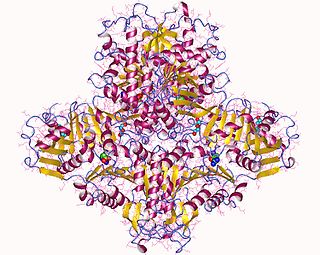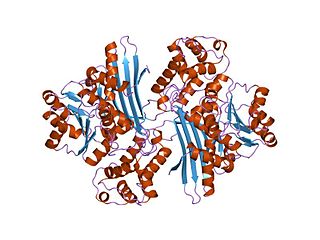This page is based on this
Wikipedia article Text is available under the
CC BY-SA 4.0 license; additional terms may apply.
Images, videos and audio are available under their respective licenses.
The urea cycle (also known as the ornithine cycle) is a cycle of biochemical reactions that produces urea (NH2)2CO from ammonia (NH3). This cycle occurs in ureotelic organisms. The urea cycle converts highly toxic ammonia to urea for excretion. This cycle was the first metabolic cycle to be discovered (Hans Krebs and Kurt Henseleit, 1932), five years before the discovery of the TCA cycle. The urea cycle takes place primarily in the liver and, to a lesser extent, in the kidneys.
Neurotoxicity is a form of toxicity in which a biological, chemical, or physical agent produces an adverse effect on the structure or function of the central and/or peripheral nervous system. It occurs when exposure to substance – specifically, a neurotoxin – alters the normal activity of the nervous system in such a way as to cause permanent or reversible damage to nervous tissue. This can eventually disrupt or even kill neurons, which are cells that transmit and process signals in the brain and other parts of the nervous system. Neurotoxicity can result from organ transplants, radiation treatment, certain drug therapies, recreational drug use, and exposure to heavy metals, pesticides, certain industrial cleaning solvents, and certain naturally occurring substances. Symptoms may appear immediately after exposure or be delayed. They may include limb weakness or numbness, loss of memory, vision, and/or intellect, uncontrollable obsessive and/or compulsive behaviors, delusions, headache, cognitive and behavioral problems and sexual dysfunction.

N-acetylglutamate synthase (NAGS) is an enzyme that catalyses the production of N-Acetylglutamate (NAG) from glutamate and acetyl-CoA.
Glutamine oxoglutarate aminotransferase is an enzyme and frequently abbreviated as GOGAT. This enzyme manufactures glutamate from glutamine and α-ketoglutarate, and thus along with glutamine synthetase plays a central role in the regulation of nitrogen assimilation in photosynthetic eukaryotes and prokaryotes. This is of great importance as primary productivity in many marine environments is regulated by the availability of inorganic nitrogen.

N-Acetylglutamate synthase deficiency is an autosomal recessive urea cycle disorder.
Amino acid oxidoreductases are oxidoreductases, a type of enzyme, that act upon amino acids.

Amino acid synthesis is the set of biochemical processes by which the various amino acids are produced from other compounds. The substrates for these processes are various compounds in the organism's diet or growth media. Not all organisms are able to synthesize all amino acids. Humans are an excellent example of this, since humans can only synthesize 11 of the 20 standard amino acids, and in time of accelerated growth, histidine, can be considered an essential amino acid.
Purine metabolism refers to the metabolic pathways to synthesize and break down purines that are present in many organisms.

In molecular biology, the protein domain Saccharopine dehydrogenase (SDH), also named Saccharopine reductase, is an enzyme involved in the metabolism of the amino acid lysine, via an intermediate substance called saccharopine. The Saccharopine dehydrogenase enzyme can be classified under EC 1.5.1.7, EC 1.5.1.8, EC 1.5.1.9, and EC 1.5.1.10. It has an important function in lysine metabolism and catalyses a reaction in the alpha-Aminoadipic acid pathway. This pathway is unique to fungal organisms therefore, this molecule could be useful in the search for new antibiotics. This protein family also includes saccharopine dehydrogenase and homospermidine synthase. It is found in prokaryotes, eukaryotes and archaea.
In enzymology, a 5-methyltetrahydropteroyltriglutamate—homocysteine S-methyltransferase is an enzyme that catalyzes the chemical reaction
In enzymology, a methylamine-glutamate N-methyltransferase (EC 2.1.1.21) is an enzyme that catalyzes the chemical reaction
In enzymology, a saccharopine dehydrogenase (NAD+, L-glutamate-forming) (EC 1.5.1.9) is an enzyme that catalyzes the chemical reaction
In enzymology, a dihydrofolate synthase is an enzyme that catalyzes the chemical reaction
In enzymology, a tetrahydrofolate synthase is an enzyme that catalyzes the chemical reaction
Tetrahydrosarcinapterin synthase is an enzyme with systematic name tetrahydromethanopterin:alpha-L-glutamate ligase (ADP-forming). This enzyme catalyses the following chemical reaction




